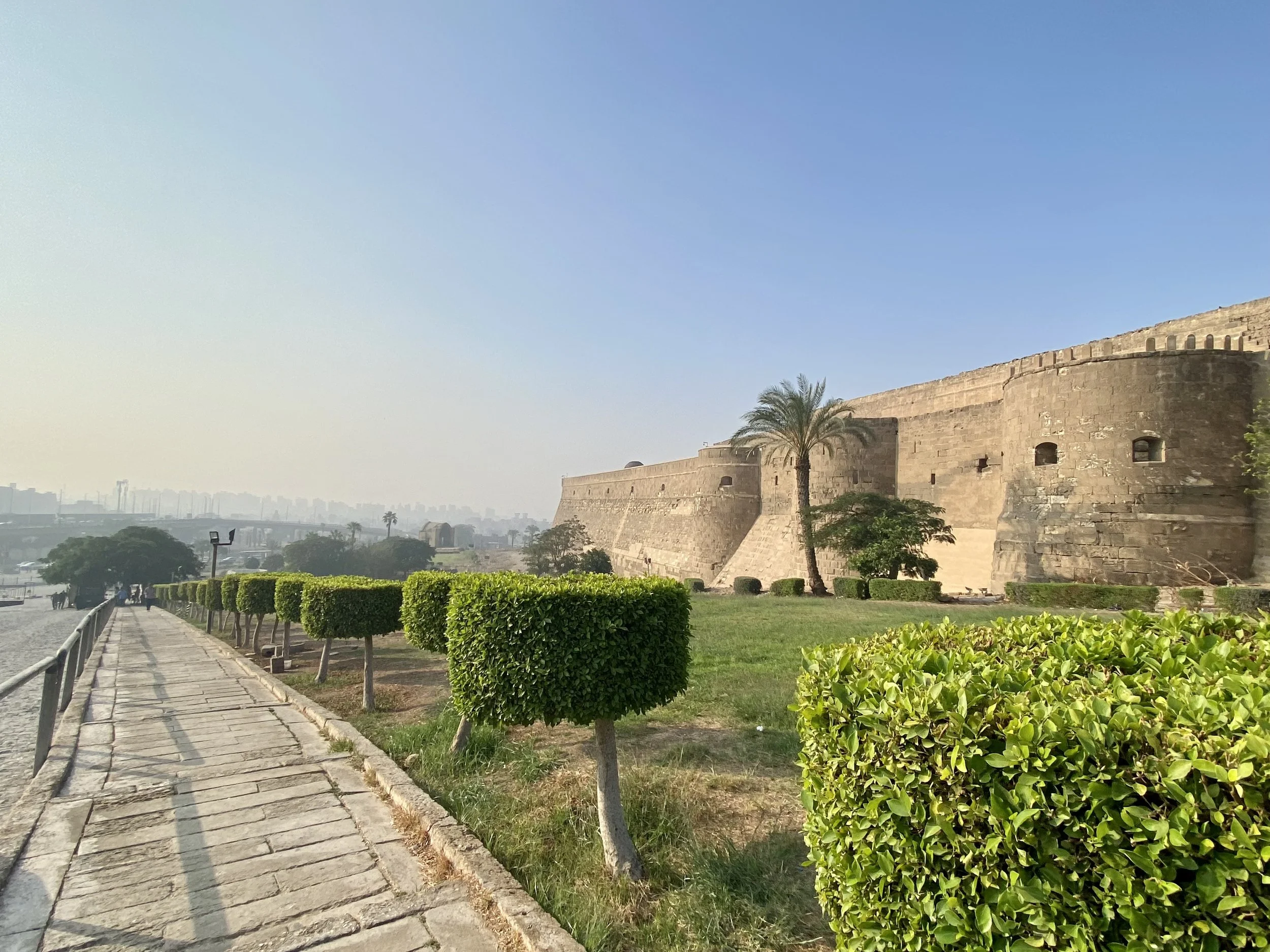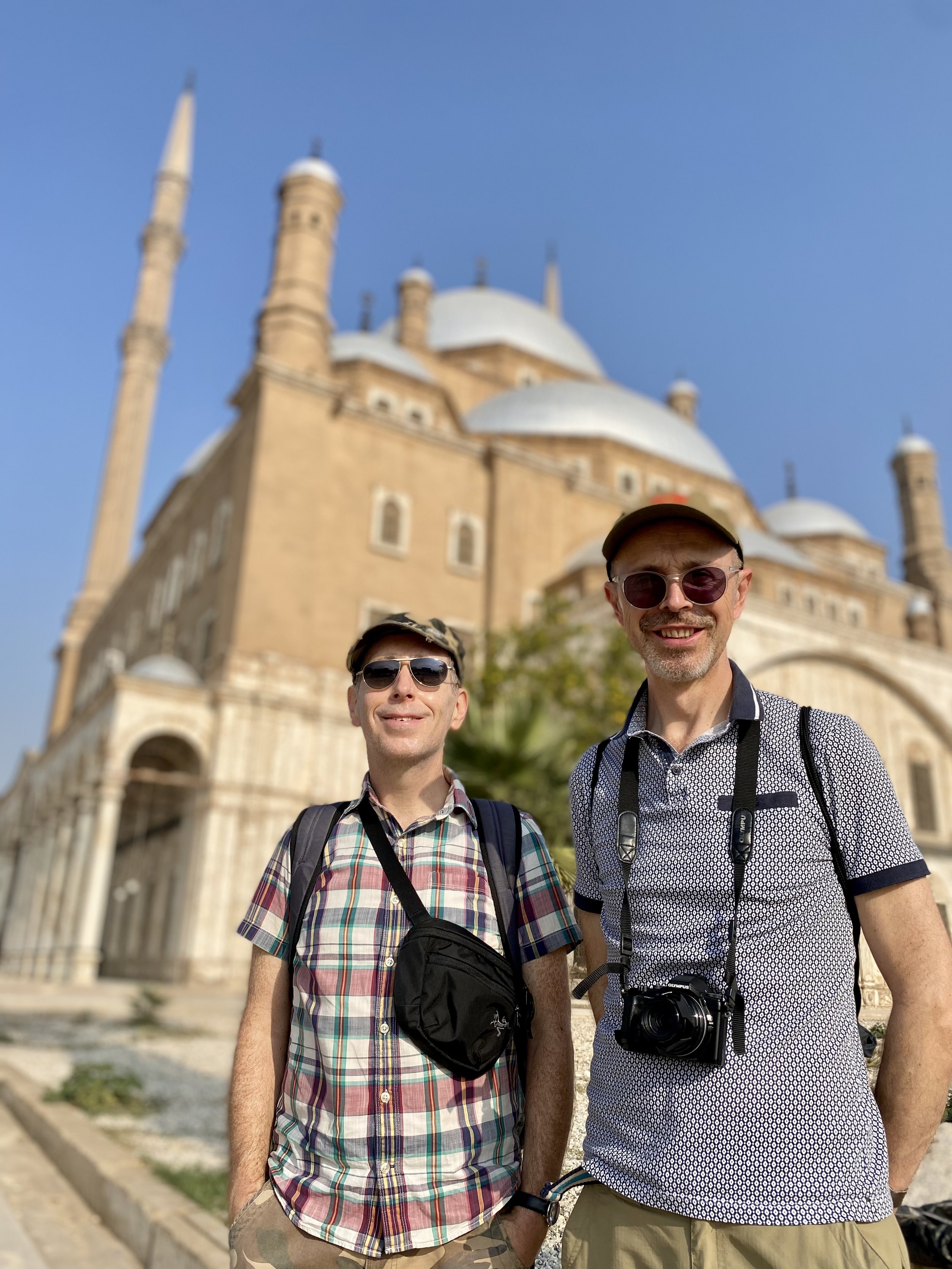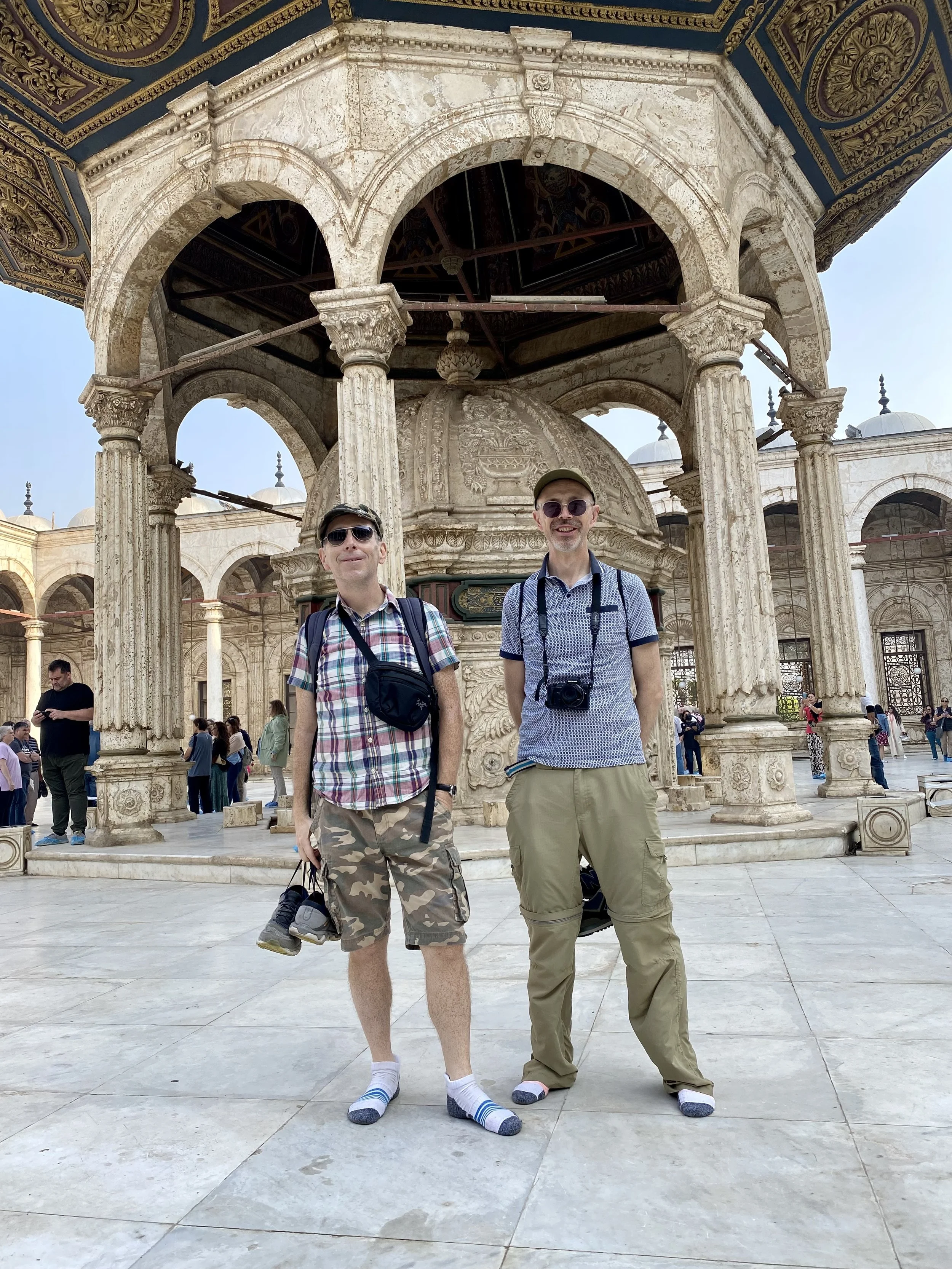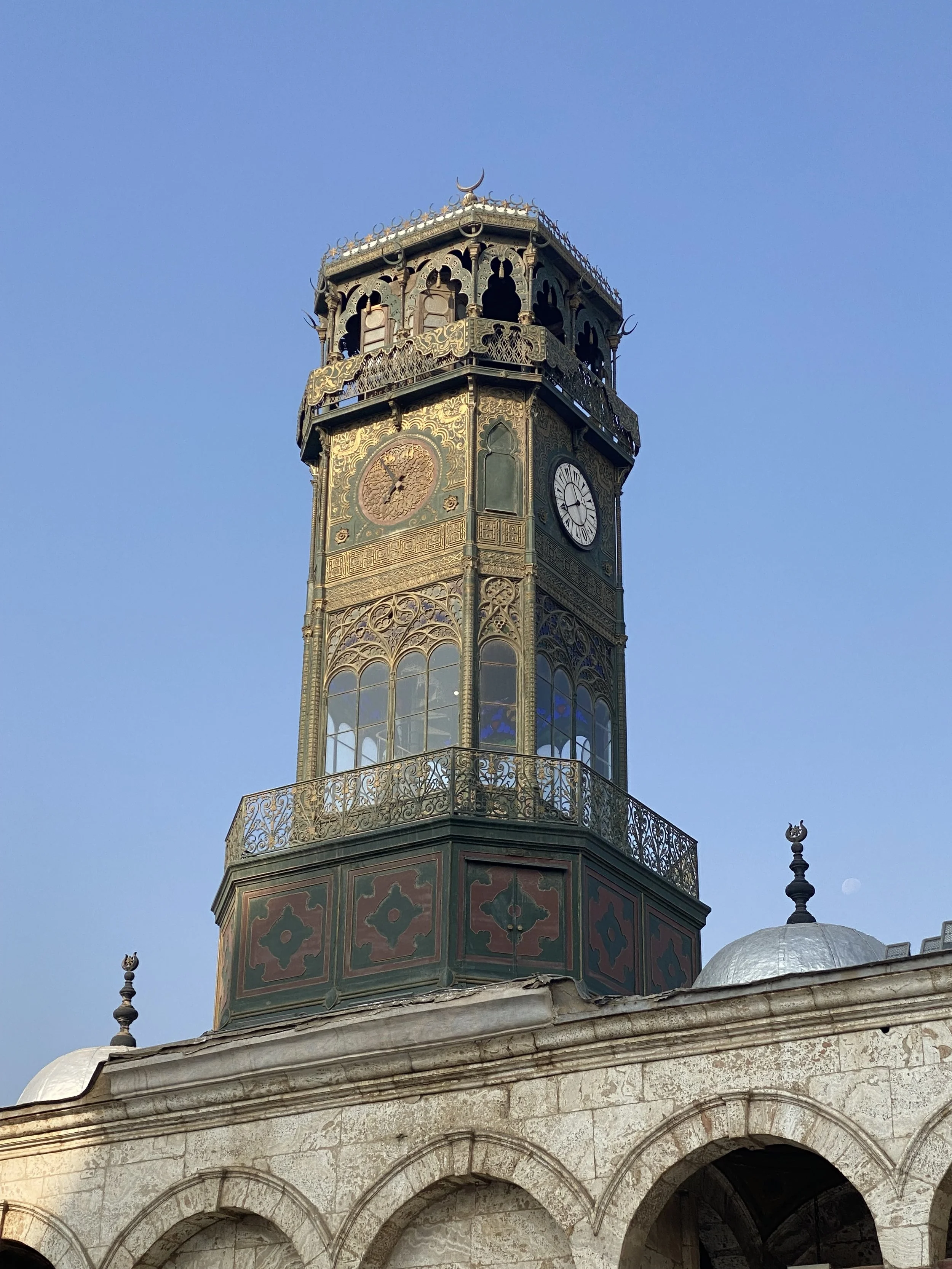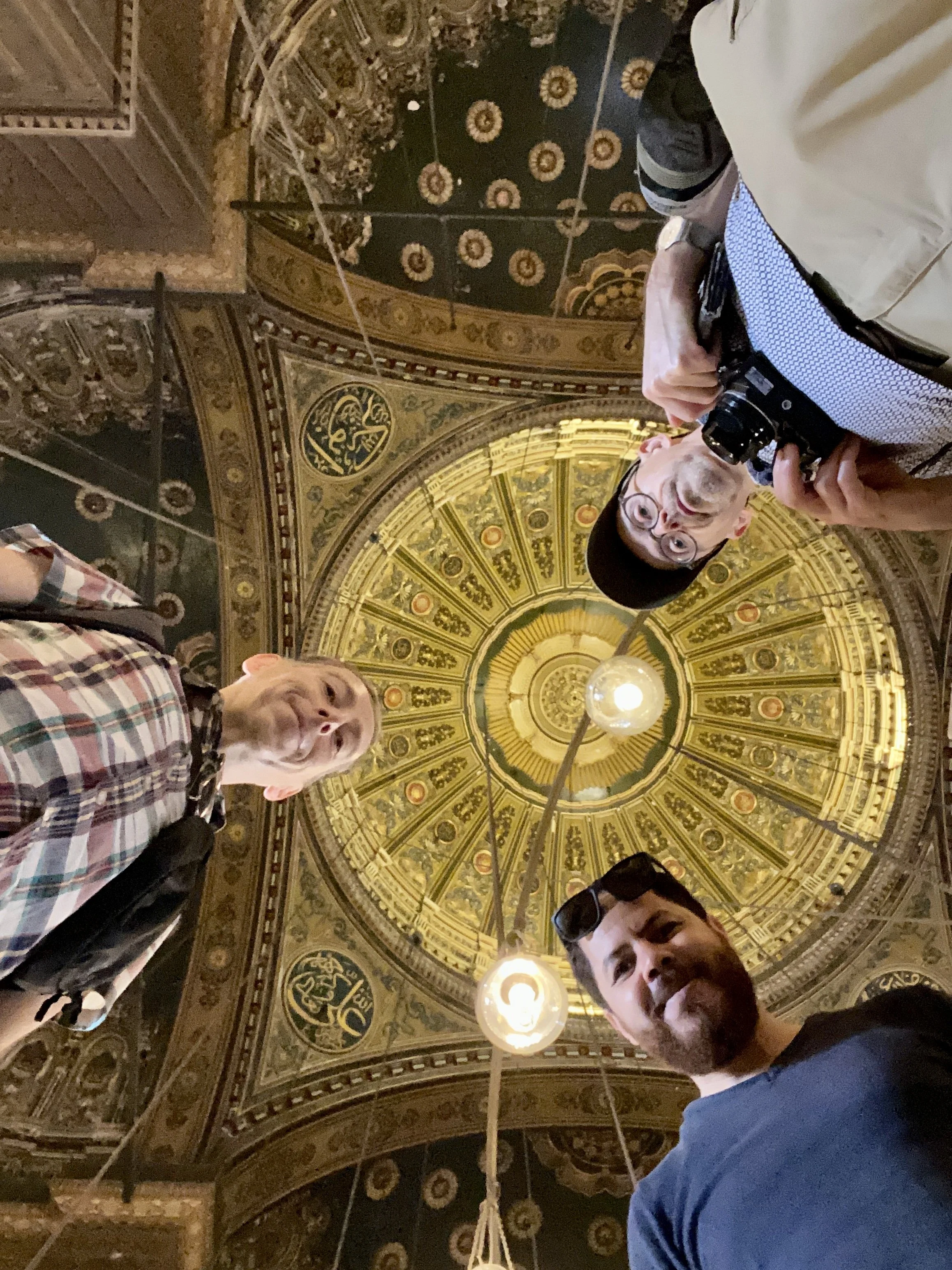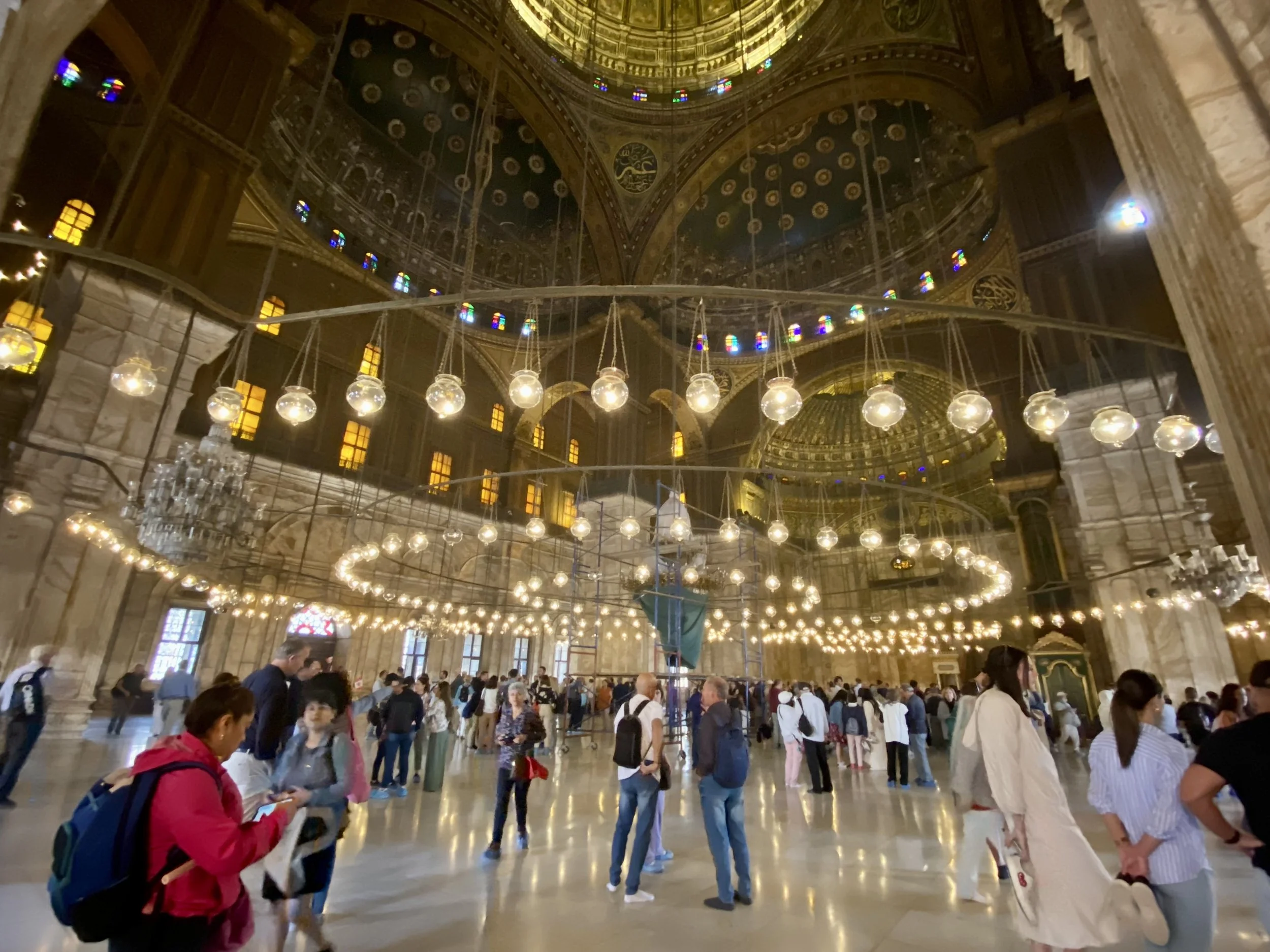The tale of Cairo may start millennia ago with the construction of the pyramids at Giza, but the Nile then charted a different course and there was no real habitation where Cairo sits today. Instead the capital of Lower Egypt in ancient times was Memphis, where we are heading tomorrow.
Old Cairo really came into being when the Arabs established their city in 641AD, having come to Egypt to offer protection for the local population who were being persecuted by the Byzantine Empire. And of course, they brought Islam to the Egyptians who had been forcibly converted to Christianity centuries earlier by the Romans.
It is old Islamic Cairo that we are visiting today in the company of our brilliant guide Mustafa, and Alaa our cheerful driver. They pick us up at 8am, and with Cairo’s working week starting on Sunday, we’re instantly weaving through rush hour traffic, with buses heaving with commuters and belching diesel into the faces of motorcyclists and pedestrians alike.
Our first stop is the Citadel of Saladin which was constructed in 1076, ostensibly to protect Cairo against a Crusader invasion, which never actually happened. But his true motivation stemmed from the great split in Islam, between the Sunni and Shia traditions, which Mustafa explains to us.
Shias believe all Islamic rulers must be directly descended from Fatima, the daughter of the prophet Mohammed, and for that reason Shias are also called Fatimids. Sunnis however believe in a more democratic version of Islam where their leaders can be chosen. Saladin was a Sunni and wanted to free Egypt from the Fatimid rule so swept into Cairo and built the Citadel to establish his own dynasty. He stripped the pyramids of their limestone cladding to use for his fortress and built the Aljawhara Palace in the grounds.
However the main draw for modern day visitors to the Citadel is the Muhammad Ali Pasha mosque which was built in 1834. A replica of the fabulous Blue Mosque in Istanbul it is stunning, a creation of decorative marble and Ottoman pencil minarets, with shiny lead-lined domes above colonnades and a beautiful fountain at the heart of the courtyard surrounded by 65 windows. Pride of place is the clock tower gifted from King Louis Philippe of France in 1833 in exchange for the obelisk from Thebes which now graces a traffic island in the Place de La Concorde in Paris.
Inside the mosque is a vast space with circular lights and a huge chandelier, currently undergoing maintenance. And above it is a huge decorative main dome, encircled by four smaller semi-circular domes to create amazing acoustics.
In the Qibla, the main arch which faces in the direction of Mecca, are two pulpits. The original is made of wood, but in 1939 the last King of Egypt, King Farouk, a direct descendant of the Ottoman ruler Mohammed Ali Pasha, gifted the mosque a marble pulpit. And by the main entrance to the mosque, behind ornate screens, is the tomb of Mohammed Ali himself.
We leave the citadel, and the tourists who are visiting, and move down the hill to the Mosque of Sultan Hasan, who was part of the Mamluk dynasty. Built in 1356 it is a vast building, easily the size of the grandest European cathedrals, with a huge open air courtyard and the four arcades each have towering arches and space for multitudes to gather and worship and teach in each of the four distinct doctrines of Islam, which Mustafa talks to us about.
He then explains the five immutable pillars of Islam, and the further six pillars beyond that. It’s a little like the Muslim version of the Ten Commandments, but focussed on personal faith, rather than laws for society.
And then, in an unexpectedly moving few minutes Mustafa takes us through his rakaa, the ritual prayers that Muslims do five times a day. We’re stood in the grand Qibla, but are almost the only visitors as most tourists don’t come here, and in the silence his recital of the prayers and movements, and explanation of what they all mean, has a profound spirituality that neither Coman nor I were expecting. We feel very privileged.
And then suddenly, streaming into the far end of the courtyard come schoolchildren laughing and running, and as we exit they all say hello and want their photos taken with us. It’s something we find all over Egypt as the days progress, local children love to get photos with us, stopping us and asking for selfies. Mustafa explains that school kids are really curious and open and love to post pictures of themselves on social media having met Western tourists. It’s a badge of pride showing how cosmopolitan they are. We’re only too happy to oblige.
Our next mosque is right next door and very similar in style. In fact the two mosques are laid out in such a way as to provide a perfectly framed view of the citadel. Yet the Mosque of Al Rifai was built hundreds of years later, at the end of the 19th century, to house the tombs of the Egyptian royal family, which ended with the military coup of 1952 that eventually brought President Nasser to power.
The tomb of Al Rifai’s grandson is exquisite, with ornate wooden screens and green lighting, but strangely the most famous tomb is of another king, the last Shah of Iran, who was buried here with full royal honours, having been given special dispensation by President Sadat. As a result, relations between the Arab Republic of Egypt and the Islamic Republic of Iran have become extremely strained.
Our final mosque, named for Ahmed Ibn-Tulun, is not only the second oldest mosque in Africa, dating back to 876AD, but the biggest at an enormous six acres. It’s wildly impressive in scale, although far less decorated than the other mosques. The huge courtyard has a large fountain for ablutions in its centre but the Fatimid style minaret is what catches our eye.
Mustafa tells us we can climb it to get a great view of the mosque and Old Cairo, and as we ascend the midday call to prayer starts to echo across the landscape with perfect timing. It’s another goose-bump inducing moment.
Next door to the mosque is the Gayer Anderson museum, which was originally a royal palace until the British doctor, and collector of antiquities, John Gayer Anderson, persuaded his patron, King Farouk, to let him live in it and restore it to former glories with many of the items he had purloined on his travels around the world. It’s also famous for having a number of scenes with Roger Moore filmed there for ‘The Spy Who Loved Me’.
As we arrive Mustafa is told that we have to be shown around by Ashraf, one of the dedicated museum guides. Mustafa seems a little surprised by this but Ashraf is very smiley and ingratiating and tells us his grandfather worked here and was “great friend of Dr Anderson!!” He obviously has a lot of pride in the building and shows us every room in far too much detail. It’s very ornate decorated with the flamboyant eye of an interior designer who was keen to let his inner peacock fly.
Gayer Anderson was married but his wife stayed at home in Lavenham Hall in Suffolk, which still houses many Egyptian treasures, while he lived in the palace in Cairo with just his Nubian servant. It’s a large building with many many rooms, but both master and servant shared the same bedroom, with a large four poster bed and a small bed in the corner for his servant. I think it’s safe to say that the servant rarely slept in his own bed.
Ashraf has obviously not considered this possibility before and bemused at our comments, instead leads us straight out of the bedroom to show us the Chinese Room, the Queen Anne room, the Library and many others. It’s fascinating but a little overwhelming especially as Ashraf keeps asking to take photos for us.
When we come to the end we hand over a small tip for his services, but Ashraf looks at us with disgust. “That is all?!” he questions. We fish out another note and explain that we weren’t expecting to have to pay a second guide (declining to mention he’d pretty much forced the situation upon us) and that we don’t have more money for him. He marches up to Mustafa and makes his displeasure known but Mustafa ushers us out and tells us not to worry.
It’s a familiar tale wherever we go. Despite paying various different companies in advance for all our excursions, everyone expects a tip for everything, and working out what is an acceptable amount is nigh on impossible. Sometimes it’s too small, and sometimes people seem amazed by our generosity. We just do our best, trying to do speedy mental arithmetic whenever we’re caught on the hoof, as £1 GBP is £28 Egyptian.
Our next stop is lunch downtown at a famous restaurant bearing the name of its owner Abou Tarek. It seems that Mr Tarek is a bit of a celebrity and the walls are plastered with photos of him appearing on various Egyptian TV programmes and chat shows, each with him posing with his trademark finger against his face. He even has a gaudy portrait of himself doing the same, along with a Guinness World Record certificate for having baked the world’s biggest dish of koshary in 2015, weighing 8 tons.
And it’s koshary, and only koshary, that his establishment serves across its four bustling floors, with shiny tables and crystals lights. It’s a rather tasty - and carb-heavy - mixture of rice, pasta, lentils and chickpeas, over which is poured a tomato sauce that can be pimped to taste with hot chili sauce and vinegar. We eat with Mustafa and Alaa, with Mustafa excusing himself for ten minutes to say his afternoon prayers.
When he returns we talk about the pop videos playing on Egyptian MTV on the screens around the restaurant.
Mustafa is not a fan of the biggest pop stars because they use bad language and are too sexy. He prefers music with a positive message. However he’s a huge fan of the English premier league and supports Liverpool and tries to persuade his nine year old son to follow him, but his son keeps switching allegiance across different English teams so Mustafa has to keep forking out for different team t-shirts.
We have one final sight of Islamic Cairo to see so leave the French-era building and boulevards of wealthier downtown and return to the older environs of the Khan El-Khalil bazaar. Constructed in 1382 by the then sultan exhuming the Fatimid cemetery and building a shopping mecca on top, Mustafa tells us you can buy almost anything within its winding souk-like alleyways. And sure enough, every conceivable spice, souvenir, leather bag, rug, animal pelt, lamp, item of clothing or furniture and beyond is stuffed into every corner. Coman describes it as “Amazon for the Middle Ages”.
We walk along Al Moez street, the oldest shopping street in Cairo, and end our tour in El Fatamy, where restaurants and coffeeshops fight for our custom and musicians play for the entertainment of passers by. Emerging from the bazaar Mustafa calls Alaa to pick us up but can’t get through. It seems Alaa’s phone has died. After repeated unsuccessful attempts Mustafa decides to hail a beaten-up taxi on the street, which is a somewhat rickety affair but a real locals’ view of the traffic-choked streets of rush hour Cairo.
Back at the hotel we say goodbye to Mustafa, whose friendliness, company and insight has been wonderful. We give him a very healthy tip to his genuine surprise, and then soothe our aching feet with a swim in the pool and watch the sunset, before a sauna and jacuzzi in the spa. Our evening plan was to walk up to 26th of July Street in Zamalek, to check out the restaurants and nightlife there but Coman’s stomach is starting to have dangerous rumblings so we decide to stay close to hotel porcelain and eat at Osmanly again.
However by the time we’re ready for dinner Coman’s decided he’d better not eat anything at all so we head up to the Jazz Bar on the 10th Floor and sit overlooking the night time glitz of the Nile with its illuminated fountain display in the middle of the river, boats cruising up and down, and lasers circling from the roof of the Sofitel at the southern tip of Zamalek, while big band jazz plays, fellow guests smoke cigars and I drink red wine and eat nachos.
It’s not a bad end to a long day!
